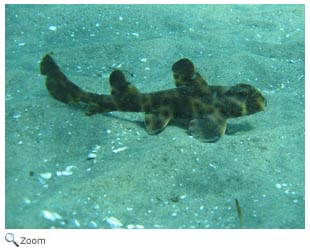|  There are 9 species in this order in one family, Heterodontidae. The sharks in this order and family are 2-5 feet long and have big, broad heads; pig-like snouts; five pairs of gill slits; a stiff spine on both of their dorsal fins; and an anal fin. They have cone-shaped teeth in the front of their mouths and fat, grinding molars in the back of their mouths. There are 9 species in this order in one family, Heterodontidae. The sharks in this order and family are 2-5 feet long and have big, broad heads; pig-like snouts; five pairs of gill slits; a stiff spine on both of their dorsal fins; and an anal fin. They have cone-shaped teeth in the front of their mouths and fat, grinding molars in the back of their mouths.
They are found in shallow water in the
western and eastern Pacific Ocean and the western Indian Ocean. They eat
small fish, crustaceans, and mollusks. Species include:
the crested bullhead shark, the horn shark, the
Japanese bullhead shark, the
Mexican hornshark, the
Galapagos bullhead shark, the
zebra bullhead shark, and the
port jackson shark.
World Status Key
 Least Concern Least Concern  Near Threatened Near Threatened  Vulnerable Vulnerable  Endangered Endangered  Critically Endangered Critically Endangered  Extinct in Wild Extinct in Wild  Extinct Extinct
Status taken from ICUN Redlist. If no status is listed, there is not enough data to establish status, or there is no status data for the species.
US Status Key
 Threatened in US Threatened in US  Threatened in NH Threatened in NH  Endangered in US Endangered in US  Endangered in NH Endangered in NH  Introduced Introduced
Status taken from US Fish and Wildlife and NH Fish and Game
New Hampshire Species |
|
North/Central American Species |
| None |
|
California Horn Shark - Heterodontus francisci
Mexican Hornshark - Heterodontus mexicanus |
Additional Information Resource Key
 Profile Profile  Photos Photos  Video Video  Audio Audio
California Horn Shark - Heterodontus francisci     
The California horn shark is found off the coast of California and Mexico.
Source: Arkive Intended Audience: General Reading Level: Middle School
California Horn Shark - Heterodontus francisci     
California horn sharks sometimes use their strong pectoral fins to crawl along rocks.
Source: Monterey Bay Aquarium Intended Audience: General Reading Level: Middle School Galapagos Bullhead Shark - Heterodontus quoyi    
the Galapagos bullhead shark is found off the coast of Ecuador and Peru.
Source: Arkive Intended Audience: General Reading Level: Middle School |

